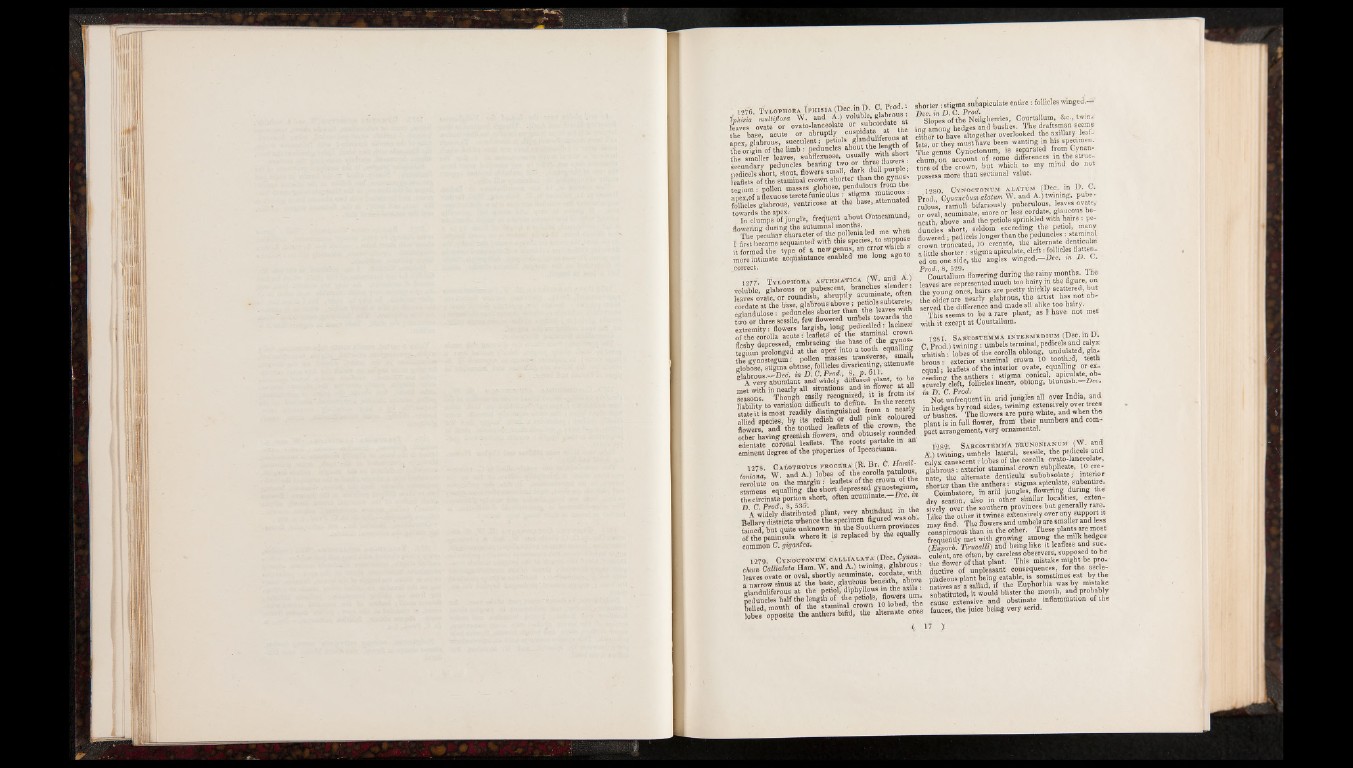
H Tylophora IpHisii.(Dec.m D. C. Prod.:
leaves ovate or ovato-lanceolate or aubcordate ar 1 — 1 or abruptly
aDex glabrous, succulent; petiols glanduliferous at
t'he origin of the limb j peduncles 13“ about the length of leaves, sufifleYu»"- SWWMI secundary peduncles bearing tw° or t e w e r 8 .
pedicels aLrt, stout, flowers small, d a r k § £ H H M
leaflets of the staminal crown shorter than the
tegium: pollen massed globose, pendulous from the
anex of a ftexuose terete funiculus : stigma muticous,
follhles glabrous, ventricos. at the base, attenuated
“ w u m p s ^ f jungfe, fregtient about Ootacamund,
flnwprinff during the autumnal months.
The peculiar character of the pollemaled me when
t first became acquainted with this species, to suppose
ft formed the type of a new genus, an error which a
more intimate acquaintance enabled me long ago to
_Correct.
shorter: stigma subapiculate entire : follicles winged.—
Dec. in D . C. Prod.
Slopes ofthe Neilgberries, Courtallum, &c., twin-
ing among hedges and bnshea. The draftsman seems
either to have altogether overlooked the axillary leaflets,
1277- TylopRora Asthmatic A (W. and A.)
voluble, glabrous or pubescent, branches slender:
leaves ovafe,-or roundish, abruptly acuminate, often
cordate at the base, glabrous above ;■ petiols sub terete,
S d u l o s e : peduncles p o r te r than the leaves with
two or three sessile, few flowered umbris towards the
extremity: flowers largish, long pedicelled : lacmeae
of the corolla a cuteleaflets ot the staminal crown
fleshy depressed, embracing the base o f th e gyu°s-
tegium prolonged at the apex into a tooth equalling
the ffvnostegum: pollen masses transverse, small,
Glabrous.—Dec. in &. C. Prod., 8 ,,p . 6 l l .
g A very abundant and widely diffused plant, to be
met with in nearly all situations and in flower at all
seasons. Though easily recognized, it « from its
liability to variation difficult to'defihe. In the recent
state it is most readily distinguished from a nearly
allied spedes, by its redish or didl pmk coloured
flowersf and thb toothed leaflets of the crown, the
other having greenish flowers, and obtusely rounded
edentate cfrnnal leaflets. The roots' partake nr an
eminent degree of the properties of Ipecacuana.
1278. CaeotropI s procbsra (K. Br. 6 . Haml-
ioniana, W. and A.) lobes of the corolla patulous,
revolute on the margin: leaflets'of the crown of the
stamens equalling the short (lepressed gynostegmm,
thecireinate portion short, often acuminate.—Dec. m
^A^widely distributed plant, very abundant ih the
Bellary diatricts whence the specimen figured: was ob.
tainedf but quite unknown in the Southern provinces
6f the peninsula where it is' replaced by the equally
Common C, giganied.
1279. CyNO'CTO'NUM CALLIALATA (DhC. CyMK-
chum Callidiata Ham. W. and A.) twining, glabrous:
leaves ovate or oval, shortly acuminate, cordate, with
a narrow sinus at the base, glaucous beneath, above
glanduliferous at the petiol, diphyllous in the axils .
peduncles half the length of the petiols flowers urn*
belled, mouth of the staminal crown 10 lobed, the
lobes opposite the anthers bifid, the alternate ones
or they must have been wanting in his specimen.
The genus Cynbctonum, ia separated fromCynan-
chumyon account of some differences in theistrnc
tore of thé crown, but whifch to my mmd do not
possess more than sectional value.
logo. Cynoctonum a lAtum (Dec. in D. C.
Prod Cvaobcfet/m alatum W. and A.) twining, pube-
rnlous, ramuli bifarionsly pnberulous, leaves ovate,
or oval, acuminate, more or less cordate, glaucous beneath,
above and the petiols sprinkled with hairs : peduncles
short, seldom exceeding the petiol, many
flowered, pedicels longer than the peduncles : stem nal
crown truncated, 10 crenate, the alternate denticulse
a little shorter 1 atigma apiculate, cleft: follicles flatten,
ed on one side, thé angles winged.—Dec. tit V . o .
FrConrtahum flowering during the rainy months. The
leaves' are represented much too hairy in the figure, on
the young ones, hairs arc pretty thickly scattered, but
thé older are nearly glabrous, the artist has not observed
thé difference and made ali alike too hairy.
This seems to bfe a rare plant, as I have not met
with it except at Courtallum.
j28I. SarUostemma intermedium (Dec in Hf.
C Prod.) twining : umbels terminal, pedicels and calyx
whitish: lobes of the corolla oblong, undulated, gla^
brous: exterior staminal crown 10 toothjd, teeth
equal; leaflets of the interior ovate, equalling or ex-
reeding the anthers : stigma conical, apieulate.ob-
acnrely deft, follicles linear, oblong, blunttsh.—Dec.
in D\ C. Prod.' . _■ j . j Not unfrequent in arid jungles all over India, and
in hedges byroad aides, twining extensively over trees
o( bhsheS. The flowers are pure white, and when the
plant is in full flower, from' their numbers and compact
arrangement, very ornamental.
1282'. SarcostBmma bOunonianum (W. and
A ) twining, umbels lateral, sessile, the pedicels and
calyx canescent -lobes of the corolla ovato-lanceolate,
glabrous: exterior ataminal crown anbplicate, 10 crenate
the alternate denticulk aubobsolate; interior
aborter than the anthers 9 stigma apiculate, subentire,
Coimbatore, m arid jungles, flowering during the
dry season,- alio in other similar localities, extensively
over the southern provinces but generally rare.
Like the other it twines ektenaively oyer any support it
mav find. The flowers and umbels are smaller and leas
conspicuous than in the other. These plantsi are most
frequently jnet with growing among the milk hedges
l& o r h . Tinicalti) and being like it leafless “ id succulent,
are often, by careless observers, supposed to be
the flower of that plant. This mistake might be pro.
duetive of unpleasant consequences, for the ascle-
pfadeoUs plant being eatable, is sometimes eat by the
natives aS^a Ballad, if the fiuphorbia was by mistake
substituted, it tfould blister the month, and prrotnUy
cause ek tensive and obstinate inflammation of the
faucek, the juice being very acrid.